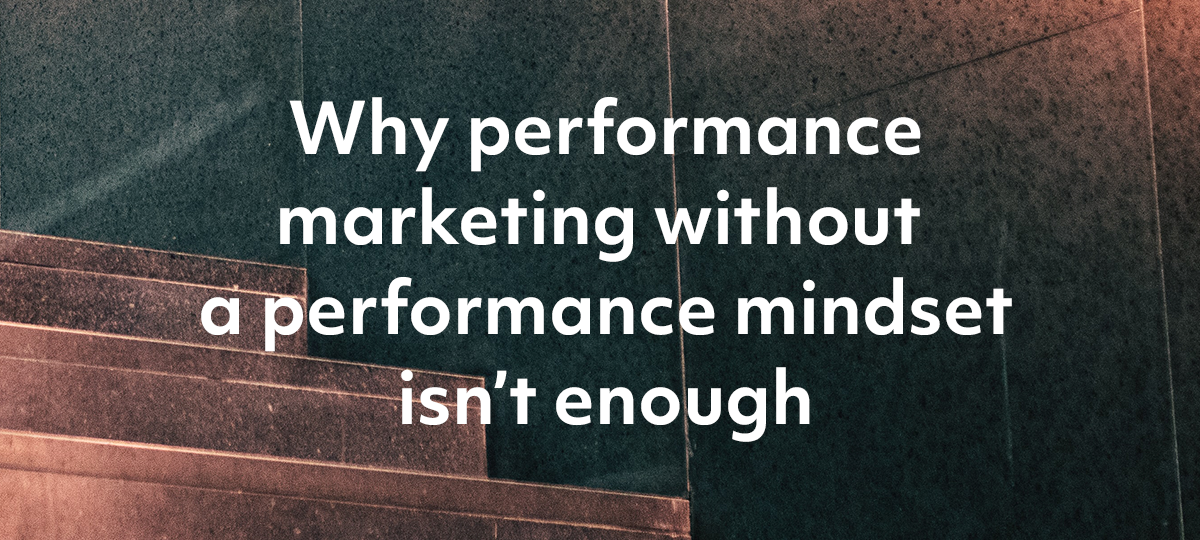
Even with consistent performance marketing growth for the last decade and worldwide digital ad revenue predicted to grow by 85% by the end of 2026, performance marketers can’t afford to rest on their laurels. Customer journeys are becoming less linear, and competition can be internal as well as external – it’s adopting a performance mindset that ensures results.
Take a telecoms provider, for example. With different departments (for example, broadband sales vs phone contract sales) using performance marketing to drive towards its own goals, two internal messages are competing for the same customer attention. A performance mindset solves this problem by taking performance marketing from a strategy to an attitude – a way of thinking. Empowered by good use of first-party data, it could be the difference between a brand achieving an ROI target or not.
As marketers, we should all be adopting the key attributes of a performance mindset, including those working across different departments. These include:
Maximising efficiency across all channels
First and foremost departments should be communicating frequently and there needs to be strong channel integration. Perhaps the answer is to have one budget with one goal and then to decide across all channels what the make-up of the activity should be? A mix of these different channels and departments can work together to achieve the initial overarching objective.
Always looking at the bigger picture – never just granular detail
With so many different, smaller components to marketing, businesses can sometimes forget to focus on looking at the bigger picture and working towards a wider marketing strategy. Focusing on the macro not the micro allows everyone to be more agile, keep stronger customer connections and maintain consistent branding.
Galvanising everyone toward the same north star using first party data
Much of this comes down to galvanising everyone under one north star. Assets and learnings should be shared across teams and across the business. This is where the data comes in.
With an ever-expanding mix of channels and platforms to communicate and interact with customers through, it is even more important for agencies and marketing teams to work collaboratively. First-party data (data collected directly from customers) is a route to bringing teams together. This data can help all marketers understand how their activity nudges customers along the value chain; how it impacts results and delivers more personally relevant customer connections. And, again using first-party data and measurement, attributing performance across channels, everyone in the mix understands how they impact and deliver results.
By sharing regularly, the team can become more invested in the goals not just their part of the process or their individual objectives, but of the whole.
Performance planning – using data as a guiding light
Data ensures you can put your best foot forward. It’s a guiding light in the creative process. It shifts the focus from subjectivity to objectivity. You can involve everyone in every stage of the process – show the creatives how assets are performing so they can see what they should do more of and what they should do less of.
Testing is critical to this as it gives you your concrete impact of what happens if we try X vs Y and what should we do more or less of, to drive a better performance. By showing the impact of using data to understand, intelligently target and communicate to your audience and the increase in success metrics it brings, you can unify business and marketing goals with customer level objectives that drive better results.
Customer-first decision making – what should we be saying/asking our customer to do?
Having a performance mindset ensures alignment across channels, thinking about how to maximise each one in relation to the other, and asking ‘What do we want the customer to do?’ and ‘How can each of these channels contribute to our efforts in encouraging them to do it?’
Too often there is internal competition, and business goals, which leads only to mixed messaging and confusion around what customers are being asked to do, and ultimately impacts engagement, response and conversion.
Through the deep understanding of your base that first-party data allows, customers can be encouraged along their value journey and the brand can look to measure and optimise to the right metric for that customer. Let the data direct that at a customer level – be it the download of an app, obtaining one more visit, registering on your website, sales of a product or simply driving awareness. by optimising in the right way you can direct your customers to their next best, and most logical, action.
A performance mindset brings unity and a shared focus: it’s a relay team, not a group of individual sprinters. And by putting customer and first-party data at the heart of your decision making across teams, your performance marketing will perform even better – leading to unrivalled ROI.
The article was first published on Performance Marketing World, May 2022
Written by Andrew Terry, Head of Strategy
CRM. Unleashed.